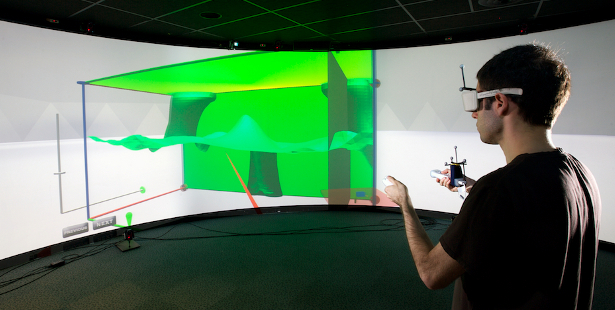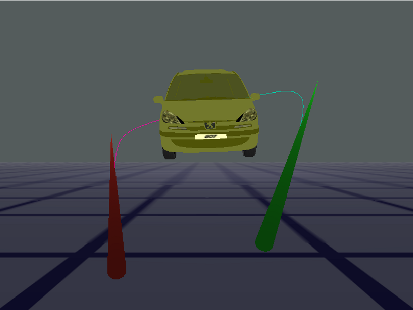Research
Topics
- 3D interaction techniques
- Immersion in virtual environment
- Intuitive interaction
- Realistic interaction
- Integration of user's physical environment
- Collaboration in virtual environments
- Collaborative interaction
- Shared manipulation on shared virtual objects
- User awareness and perception
- Distributed virtual environments
- Data distribution
- Consistency maintenance
Ph.D. work
Subject: "Sharing of Interaction in Virtual Environments: new Collaborative Techniques based on a Generic Communication Protocol" (in french: "Partage d'interactions en environnements virtuels : de nouvelles techniques collaboratives basées sur un protocole de dialogue générique").
Supervisors: Pr. Bruno Arnaldi, Pr. Thierry Duval.
Team: Bunraku at the laboratory IRISA-INRIA Rennes.
Grant: This Ph.D. is supported by the French National Research Agency (ANR) in the Part@ge project. In french, 'Part@ge' means 'Sharing'. This project aims at helping collaborative interaction in virtual environments through the creation of new technical infrastructures, new interaction tools/metaphors for virtual environments, and new scientific knowledges.
- Abstract:
Virtual reality enables users to manipulate virtual objects from local or distant sites. Nevertheless, virtual objects are usually manipulated by only one user at a time.
In this thesis, we define an interaction protocol describing how interaction tools and interactive objects communicate. This message-based protocol handles local and distant interactions on interactive objects for single or multi-user situations. It also manages permissions for access of interaction tools. Moreover the development of this protocol led to the definition of interaction tools and interactive objects. This characterization has driven an implementation based on a set of reusable software components that let an interaction tool modify how it selects or modifies interactive objects, and let an interactive object modify its own behaviour when it is manipulated. On top of that, extensions to the COLLADA file format based on this characterization and dedicated to collaborative interaction are proposed.
A new technique for multi-user interaction is proposed. Movements in 6 degrees of freedom are deduced from the positions (not orientations) provided by 3 virtual hands. This technique thus enables two or three users to manipulate together virtual objects. The ability given to users to put precisely their virtual hands brings them a way to imitate better reality. In fact, users' feeling during a manipulation can depend on how users hold this object notably with cumbersome objects. Therefore, this technique aims to obtain realistic hand positions and gestures of users. The implementation is built upon the interaction protocol.
A new concept of reconfigurable tangible interface for single or multi-user interaction is also proposed. This interface provides a way to manipulate virtual 3D objects. This interface, named RTD, proposes a reconfigurable physical mesh made up of manipulation points that have to be put on a virtual object, like grasping points. This mesh thus roughly sketches the form of the virtual object to manipulate. Two kinds of RTDs are illustrated in this thesis. A first kind of RTD is a triangular shape. It is named RTD-3 and so made up of three manipulation points. Experiments show that users prefer this technique over classical techniques of virtual reality like the mean of users’ movements or the separation of degrees of freedom. A second kind of RTD is made up of four manipulation points and exists in two versions. The plane RTD-4 has its four points laying on a plane to create a quadrilateral. The non-plane RTD-4 uses articulated joints at its manipulation points to obtain a tetrahedron. A 3D form for a RTD would lead to better matching between the form of a RTD and the form of the virtual object to manipulate.
Report: The report can be downloaded on this website or on the TEL archives.
Making: All the implementations have been realized on the virtual reality platform OpenMASK, in C++, by the use of Ogre3D for graphics, Bullet (C++) for physics, and MPI (MPICH2) to run the simulation on several computers.
The following video gives an overview of the Part@ge project.
The following video illustrates the use of RTD-3 and RTD-4. During these experiments, two users had to move together a virtual car hood (the yellow object on screen) while avoiding collisions. The optical tracking was achieved by A.R.T. infrared cameras placed around the screen: 3 attached to the ceiling and 2 on the floor.
The Reconfigurable Tangible Device with 4 points (RTD-4):
The Reconfigurable Tangible Device with 3 points (RTD-3):
Although the generic communication protocol has been used for all the implementations of collaborative interaction, find below a test for interaction through gestures to illustrate the generic architecture that has been obtained (voice could also be used):
The following pictures illustrate (from left to right):
- one 3D virtual ray being moving the car
- two 3D virtual rays being moving the car at the same time so concurrent actions are automatically managed. Curved lines are displayed to aware users that the result of their actions also depend on the action of other users
- the ray on right has left so only one 3D virtual ray is still interacting:
Copyright notice - Disclaimer: this material is presented to ensure timely dissemination of scholarly and technical work. Files of articles may be covered by copyright. You may browse the articles at your convenience in the same spirit as you may read a journal or conference proceedings in a public library. Retrieving, copying, distributing these files, entirely or in parts, may violate copyright protection laws. Copyright and all rights therein are retained by authors or by other copyright holders. All person copying this information are expected to adhere to the terms and constraints invoked by each author's copyright. In most cases, these works may not be reposted without the explicit permission of the copyright holder.







